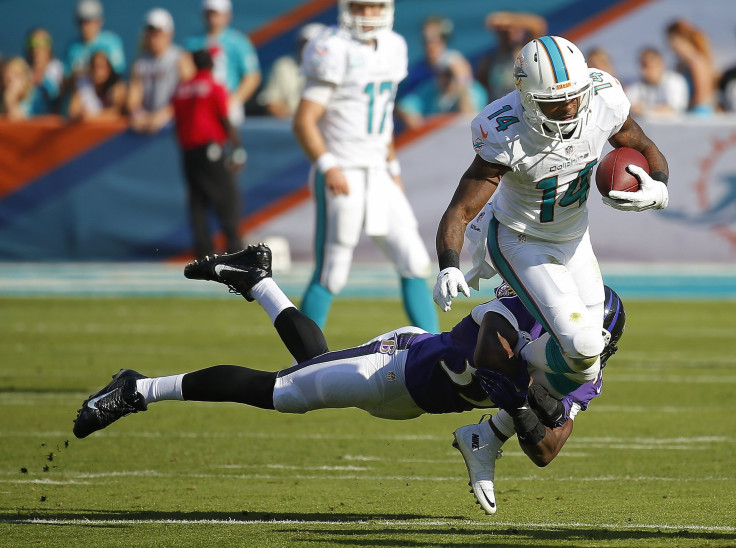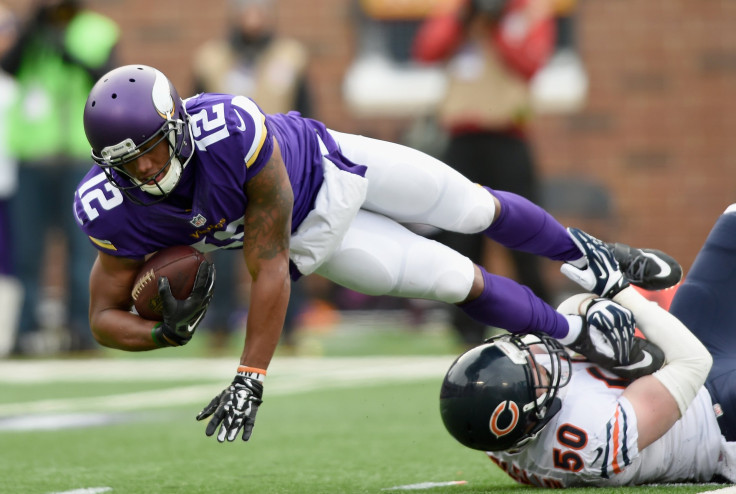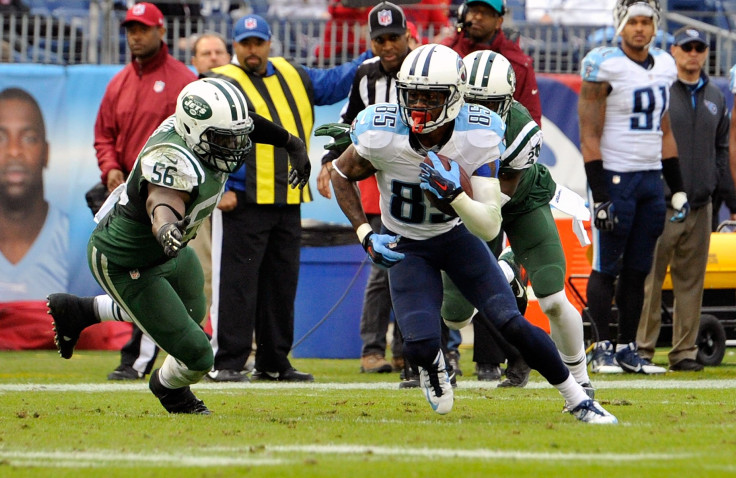Fantasy Football 2015 Sleepers: 9 Under Valued Wide Receivers To Draft And Win Your League

The passing game has taken over the NFL in recent years, making a strong wide receiver corps tantamount to success. Overall, NFL teams opted to pass on 56.6 percent of their plays last season, which was only a shade down from 56.9 percent in 2013. Back in 2012 it was a solid 56 percent. Furthermore, 15 teams, almost half the league, passed more than 60 percent of the time last season, compared to 12 teams in 2013, 11 in 2012, nine in 2011, and seven in 2010.
Digging a little deeper you’ll find that one topline running back no longer carries a fantasy squad. The reason running backs ruled fantasy for so long was the number of touches they’d get per game. Assuming a back can earn 20 snaps a game and play all 16 games, he’d average 320 rushes per game. Yet last season only two running backs even eclipsed 300, DeMarco Murray with a whopping 392 and LeSean McCoy with 312. In 2013, no rusher averaged 20 attempts a game with McCoy leading the way with 314. And in the last five years only twice, 2010 and 2012, has more than one rusher averaged 20 touches a game.
In contrast, 49 pass catchers accounted for 101 or more targets last season, and all but four of them averaged better than 10 yards per catch. In most leagues owners must start three receivers every week, and while they won’t snag 20 balls a game by themselves, as a collective they can put up 30 to 50 fantasy points a week.
Some of this has to do with likes of McCoy, Chicago’s Matt Forte, Pittsburgh’s Le’Veon Bell, and Kansas City’s Jamaal Charles breaking the traditional mold of running backs and catching passes out of the backfield. But that only strengthens the growth of the passing game.
To bottle the issue, it really comes down to teams employing a two-man running back rotation to keep their stars fresh and allowing the offense flexibility should anyone go down to injury or they face an especially strong defense.
Receivers have benefitted from the NFL’s transition each of the last five years. Consider in 2011 that only 17 pass catchers totaled 1,000 yards or more. In 2014 that number ballooned to 23. And the NFL’s crack down on secondarys has allowed receivers more room to work with off the line scrimmage and even down field, making the potential for big plays even greater.
Now, as a fantasy owner, how can you cash in on this craze? One way is using one of your first two draft choices on elite receivers like Pittsburgh’s Antonio Brown, Denver’s Demaryius Thomas, Dallas’ Dez Bryant, Green Bay’s Jordy Nelson, or Detroit’s Calvin Johnson.
But that’s an approach that misses the much bigger picture. Owners these days can find a ton of undervalued talent late in drafts, and use their first picks on one of the rare running backs that are still the focal point of their offenses.
Using FantasyPros Average Draft Position (ADP), we’ve identified the top sleeper wide receiver candidates, or unheralded players, that owners are neglecting in drafts before the start of the fantasy season.
First, let’s make the definition of a sleeper clear. A sleeper doesn’t necessarily mean a player no one’s ever heard of before. Instead, it can be a player who dropped off last season or over the course of the last few seasons, and could be an undervalued commodity in fantasy drafts ready for a comeback in 2015. Or rather, it’s a player expected to give very little this season but explodes to the delight of the owner smart or lucky enough to land them.
Here are the top sleeper wide receivers to draft for 2015 fantasy football season.
2015 Sleeper WRs
Jarvis Landry, Miami Dolphins (No. 74)
Last season, Mike Wallace, Charles Clay, and Brian Hartline combined for 262 of Miami’s 595 targets, and now all three are gone. Landry was the other LSU receiver, not named Odell Beckham Jr., to make major waves last season with 84 receptions for 758 yards and five touchdowns off 111 targets last season, and those numbers should rise in his second season.
Charles Johnson, Minnesota Vikings (No. 107)
With Greg Jennings gone, Johnson becomes Minnesota’s No. 1 receiver and quarterback Teddy Bridgewater won’t see as punishing a pass rush with Adrian Peterson returning to the backfield. Bridgewater took 39 sacks last season, but over the final six games of the season he developed a rapport with Johnson, finding him for 40 of his 58 total targets, even against some of the better secondarys in the league in Green Bay, Detroit and Miami.
Pierre Garcon, Washington Redskins (No. 132)
The arrival of DeSean Jackson and a three-man quarterback rotation that was sacked 58 times last season (the second-worst in the NFL) caused Garcon’s production to slip precipitously to only 68 receptions for 752 yards and three touchdowns in 2014. But he did lead the Redskins with 105 targets, so the opportunities are there for Garcon. Also, Jackson might not be 100 percent to start the season after he suffered a Grade 2 separated shoulder during training Thursday. Entering his second season under head coach Jay Gruden and offensive coordinator Sean McVay, Garcon should have a far more productive year than his ADP suggests.

John Brown, Arizona Cardinals (No. 135)
Michael Floyd’s injury moves Brown right behind the fading Larry Fitzgerald, and over the first few weeks of the season Brown has the talent to outshine the veteran All-Pro. With Carson Palmer and running back Andre Ellington healthy, Brown should benefit from a more-balanced Cardinals offense.
Dorial Green-Beckham, Tennessee Titans (No. 179)
The rookie has some stiff competition from Justin Hunter and Kendall Wright, and enters the league beside rookie quarterback Marcus Mariota, but the Titans No. 22 passing offense from a year ago needed another more reliable target other than tight end Delanie Walker. With elite 6-foot-5 size, and oozing athleticism and leaping ability, Green-Beckham could mirror the production of last year’s breakout rookie receiver class. At No. 179, or the 16th or 17th round in a 10-team league, he’s well worth the risk.
Green-Beckham’s already received praise from head coach Ken Whisenhunt for his progress in training camp. Whisenhunt has a history of developing freakishly athletic big receivers. If you remember, Whisenhunt’s arrival in Arizona in 2007 sparked Larry Fitzgerald’s string of five-straight 1,000-yard seasons.
Devin Funchess, Carolina Panthers (No. 229)
For the second-straight season quarterback Cam Newton gets a brand-new, massive rookie receiver to target. It was Kelvin Benjamin a year ago, and now Funchess. He’s at No. 229 because he’s a rookie but also because Funchess only played wide receiver for one season at Michigan. Granted he put up 633 yards and four touchdowns over 11 games, but that was against Big Ten defenses, not stacked NFL secondarys.
The Panthers need to expand a passing game that ranked No. 19 in the league last season, but more specifically a red zone attack that was No. 26. Carolina scored a touchdown on trips inside the 20-yard line only 48.1 percent of the time last season, according to The Charlotte Observer, and Newton requires more options outside of Benjamin and veteran tight end Greg Olsen. Consider 268 of Carolina’s 545 receiver targets (49.1 percent) went to Benjamin and Olsen last season, and no other receiver was targeted more than 78 times.
Phillip Dorsett, Indianapolis Colts (No. 237)
The Colts are reportedly enamored with first-round draft choice Dorsett, likening his skill set to a young DeSean Jackson. As a rookie Jackson totaled 1,460 all-purpose yards, a huge year for Dorsett to live up to given how loaded Indianapolis’ offense is. He’ll have to contend with veteran Andre Johnson as well as T.Y. Hilton for targets, with the latter also being in a critical contract year. Hilton and Johnson should garner most of the targets, but more than 62 percent of the Colts plays were passes last season, which leaves a lot of room for the speedy Dorsett to work. Offensive coordinator Pep Hamilton might pull back the pass-heavy schemes with running back Frank Gore now in town, but at No. 237 Dorsett’s a perfect WR2 or WR3 in most league formats.

Nate Washington and Cecil Shorts, Houston Texans (N/A)
There’s an intense battle in Houston over who gets the No. 2 WR spot behind DeAndre Hopkins, and recent reports suggest the veteran Washington has pulled ahead of Shorts. But keep an eye on both, even if they have some glaring question marks. Washington’s four years removed from his only 1,000-yard season with Tennessee, and Shorts has never played a full season because of various injures.
Yet there are a ton of opportunities in the Texans offense now that Andre Johnson’s gone. The veteran tallied 147 targets last season, with Hopkins next at 127, and no other receiver garnered more than 59. Rookie Jaelen Strong is in the mix, but Shorts and Washington can excel whether it’s Ryan Mallett or Brian Hoyer at quarterback. Shorts is especially intriguing since he never had a reliable quarterback in his four years with Jacksonville. Hoyer could be the starter, and remember he came out guns blazing in the first half of last season with a very limited Cleveland receiving corps.
Houston may also limit running back Alfred Blue’s touches to avoid injury after Arian Foster went down earlier this week with a groin injury. The Texans have limited RB depth after Blue, which could greatly alter their 52-48 run-to-pass ratio from 2014. Something else to keep in mind, no pass defense in the AFC South ranked higher than No. 12 last season.
Owners have yet to spend a draft pick on either Washington or Shorts, which leaves them ripe for an early waiver or free agency pick up before or after Week 1.
© Copyright IBTimes 2024. All rights reserved.





















